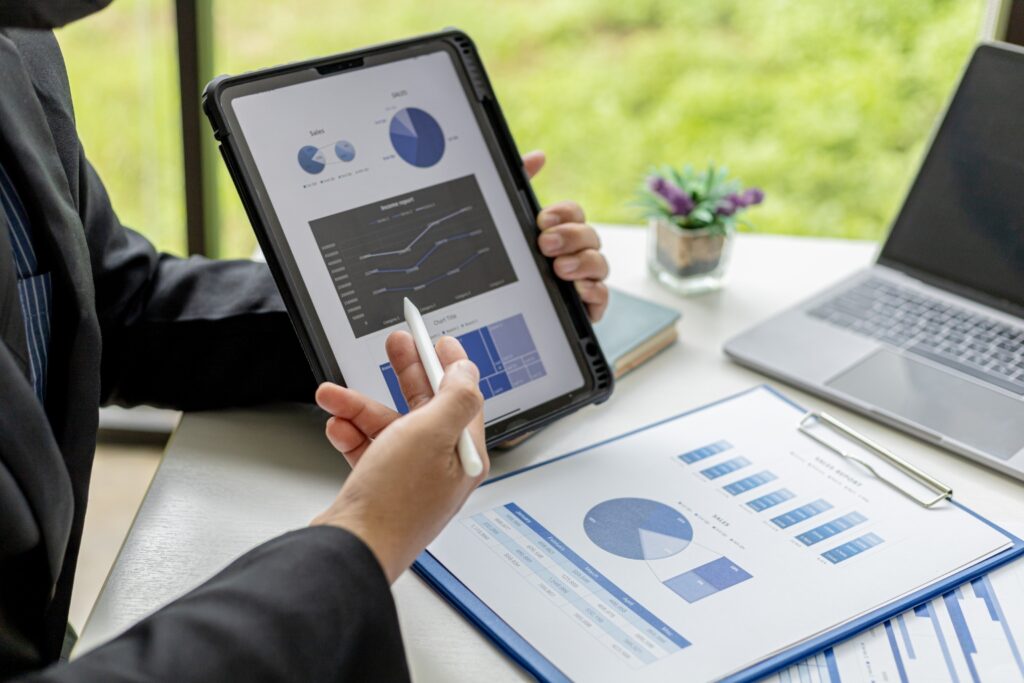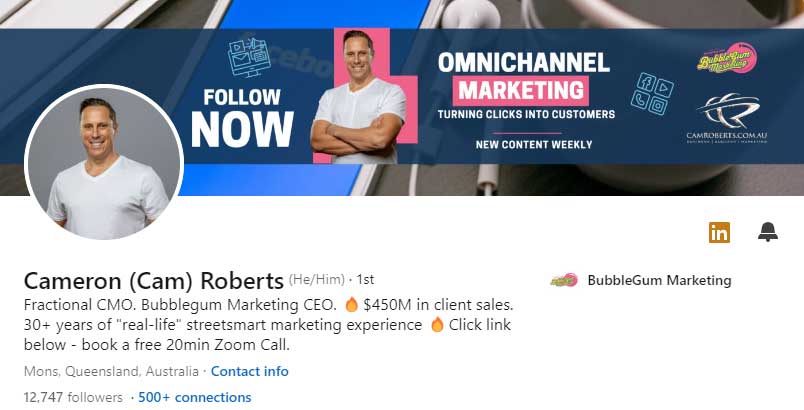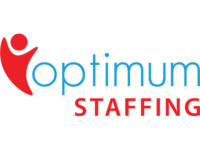How to Analyse a Marketing Sales Funnel
By Cameron Roberts – Founder & CEO of Bubblegum Marketing,
Posted On February 28, 2024
Are you losing potential customers at different stages of your sales funnel? Watching them go in the middle of the purchase can be frustrating. But you’re not alone. Most businesses face the same issue, losing valuable leads and failing to turn them into loyal customers. The good news is that you can improve your funnel by identifying hidden bottlenecks and transforming it into a conversion powerhouse.
This blog is here to help you make sense of your sales process. We’ll give you the tools and insights you need to analyse your funnel, understand customer behaviour, and optimise your approach. By following our strategies, you’ll be able to create a pipeline that delivers loyal customers and sustainable growth. We’ll cover data analysis, customer behaviour, and optimisation techniques clearly and concisely that’s easy to follow.
Understanding Your Funnel
Understanding your sales funnel is essential in marketing. It guides potential customers from initial awareness to brand loyalty and, if optimised, can lead to higher conversion rates and increased revenue. But where to start? This guide will give you the knowledge and tools to analyse your funnel, identify bottlenecks, and create a conversion machine that works smoothly.
But first, we need to understand what exactly a sales funnel is.
Think of a pyramid, where the base is everyone who might be interested in your product or service. As they move down the pyramid, they become more engaged and qualified, until only a few selected individuals remain at the bottom, ready to become paying customers. Each level of the pyramid requires specific strategies and tactics to nurture and move prospects closer to making a purchase.
So, what are the key stages of a sales funnel?
While the specific stages may vary slightly depending on your industry and business model, most funnels can be broken down into these core phases:
- Awareness: This is where you grab attention and introduce your brand to potential customers. Think social media campaigns, content marketing, and search engine optimisation (SEO).
- Interest: Now you’ve piqued their curiosity. It’s time to delve deeper into your offerings, educate your audience, and establish yourself as a thought leader. Blog posts, webinars, and free trials can be powerful tools here.
- Consideration: The prospect is weighing their options. Highlight your unique value proposition, address their concerns, and showcase social proof (testimonials, reviews) to build trust and credibility.
- Decision: Make the buying process smooth and frictionless. Offer clear calls to action, limited-time deals, and exceptional customer service.
- Loyalty: Don’t stop at the first purchase! Foster long-lasting relationships with your customers through loyalty programs, personalised communication, and exceptional post-purchase support.
By understanding each stage of your funnel and the specific actions that drive conversions, you can identify areas for improvement and optimise your marketing efforts for maximum impact.

Data Gathering and Tool
To effectively understand your sales funnel, relying solely on intuition is not enough. It’s crucial to utilise data to uncover patterns and insights that are hidden within the funnel. Although gathering and analysing data may seem daunting, this section of the blog will provide you with the necessary tools and techniques to become an expert data detective.
What data should you be gathering?
Think of your funnel as a complex ecosystem. Every stage generates valuable data points, including:
- Website traffic: Where do visitors come from? Which pages do they engage with? What actions do they take? Tools like Google Analytics and Hotjar can provide valuable insights into user behaviour.
- Lead generation: How many leads are you capturing? What channels are most effective? CRM software and email marketing platforms offer a treasure trove of lead data.
- Sales conversions: How many leads convert into paying customers? What are the conversion rates for each stage of the funnel? Sales tracking tools and analytics dashboards can reveal important conversion insights.
- Customer feedback: What do your customers think about your product or service? Surveys, interviews, and customer reviews offer valuable feedback that can inform funnel optimisation efforts.
The right tools for the job:
Are you feeling overwhelmed by the vast amount of data out there? Worry not, there are many tools available to help you tackle it. With the right tools, you can climb the data mountain with ease. Here are the tools that you can use for data gathering:
- Web analytics: Google Analytics, Hotjar, Crazy Egg – these tools provide in-depth insights into website traffic, user behaviour, and conversion paths.
- CRM software: Hubspot, Salesforce, Zoho CRM – these platforms help you manage leads, track sales activities, and analyse customer data.
- Marketing automation platforms: Keap, Mailchimp, Pardot, Marketo – these tools automate email marketing, lead nurturing, and other marketing tasks, providing valuable data on campaign performance.
- Data visualisation tools: Tableau, Power BI, Google Data Studio – these platforms help you visualise complex data sets, making insights easily digestible and shareable.
Bear in mind that the value of data depends on how it is interpreted. Once you’ve gathered your data, it’s time to analyse it with a critical eye. Identify trends, patterns, and bottlenecks. Ask questions:
- Where are most visitors dropping off?
- What content resonates best with your audience?
- Which marketing channels are driving the most conversions?
By leveraging your data detective skills and the right tools, you can find valuable insights that can transform the performance of your funnel.
Analysing the Data
Data can tell a story, but as a marketer, it is your responsibility to find the hidden secrets and use them to improve your marketing funnel. You must utilise your data analysis skills to acquire actionable insights. It’s time to take advantage of the data you have and optimise your marketing funnel!
But where do you even begin?
Start by segmenting your data based on relevant criteria like:
- Traffic source: Paid ads, organic search, social media, etc.
- Lead source: Landing pages, webinars, email campaigns, etc.
- Customer demographics: Age, location, interests, etc.
This allows you to compare apples to apples and identify trends specific to different segments of your audience. Next, dive into the metrics that matter:
- Conversion rates: What percentage of visitors go on to the next step at each stage of the funnel? Determine your weak spots and potential improvement areas.
- Engagement metrics: Time spent on a page, bounce rate, click-through rate – these metrics reveal how your audience interacts with your content.
- Lead quality: Not all leads are created equal. Analyse lead engagement, demographics, and other factors to identify high-value prospects.
- Customer lifetime value: How much revenue does a customer generate over time? This helps you prioritise engagement strategies for loyal customers.
Visualising data is as important as analysing it. Use tools like Google Data Studio and Tableau to create clear, beautiful visualisations that help you get insights from your data. Start with simple questions, find insights, and then ask more detailed questions based on what you learn. By following this process, you’ll be able to get the most out of your data.
Interpreting the Results
You have collected the necessary data, analysed it diligently, and discovered a wealth of valuable insights. However, your work is not yet complete. As a marketer, it is now your responsibility to convert those insights into actionable steps that will optimise your sales funnel and unleash its full potential for conversion. Let’s delve into the art of interpretation!
Always keep in mind that data alone is not enough. You must interpret it, become a storyteller, and create a clear image of what your funnel is doing.
Start by asking yourself:
- Where are the biggest bottlenecks? Are prospects dropping off at a specific stage? Identify the “leaky bucket” moments and prioritise improvement efforts.
- What content resonates best? Are certain pieces of content driving higher engagement and conversions? Replicate and expand on those successful strategies.
- What are your ideal customer profiles? Analyse your high-value customers and identify common characteristics. Tailor your targeting and messaging to attract more of these ideal leads.
- What are your competitors doing? Analyse their funnel strategies and identify areas where you can differentiate and outshine them.
Don’t fall into the trap of data paralysis. Sometimes, overthinking can hinder progress. Start with the low-hanging fruit – the quick wins that can be implemented easily and deliver immediate results. As you gain confidence, you can tackle more complex optimisation challenges.
Optimising Your Funnel
Now, you’ve collected data, learned its secrets, and used it to gain insights. Now it’s time to optimise your sales funnel. The process takes time and requires small adjustments, testing, analysis, and refinement. It’s like fine-tuning a high-performance engine. Expecting immediate perfection is unrealistic. Remember that optimisation is a continuous process. Keep making adjustments to achieve peak performance. Here’s your roadmap to funnel optimisation:
1. Prioritise your efforts: Start with the biggest bottlenecks and areas with the most potential for improvement. Focus on the low-hanging fruit first to see quick wins and build momentum.
2. Implement your changes: Based on your insights, make targeted changes to your funnel. This could involve:
- Improving landing page copy and design: Addressing user pain points, highlighting your value proposition, and making calls to action clear and compelling.
- Optimising your website for conversions: Ensure a smooth user experience, reduce friction points, and guide visitors towards the desired action.
- Personalising your messaging: Tailor content and offers based on user interests and behaviours to increase engagement and relevance.
- Nurturing your leads: Develop targeted email campaigns and content to educate, engage, and move leads down the funnel.
- A/B testing different elements: Experiment with different approaches to see what resonates best with your audience and optimises conversions.
3. Measure and track your results: Don’t just implement changes and hope for the best! Track key metrics like conversion rates, engagement, and customer lifetime value to see the impact of your optimisation efforts.
4. Analyse and iterate: Based on your data, analyse what’s working and what’s not. Adapt your strategies and continue to fine-tune your funnel for even better results.
Remember, optimisation is a journey, not a destination. Be patient, stay data-driven, and don’t be afraid to experiment. With each iteration, your funnel will become more efficient, more effective, and more adept at converting visitors into loyal customers.
On the Final Note
Many businesses struggle with losing potential customers and fail to turn them into loyal ones. However, by identifying hidden bottlenecks in your sales funnel, you can transform it into a conversion powerhouse and improve your sales. It’s important to understand your sales funnel in order to effectively market your business. The sales funnel can be compared to a pyramid, with various stages that require specific strategies and tactics.
The key stages of a sales funnel are awareness, interest, consideration, decision, and loyalty. To better understand your sales funnel, you can use data to uncover patterns and insights. If you’re experiencing difficulty in turning potential customers into loyal ones and losing leads in the process, BubbleGum Marketing, a reliable funnel marketing agency, can help you turn your business around. To learn more about our services, give us a call at +61 1300727983 today!
FAQs
Q. How do you analyse a marketing funnel?
Analyse your marketing funnel by tracking key metrics (conversions, engagement) at each stage. Look for drop-off points and use data (analytics, surveys) to understand why. Analyse user behaviour and content performance to identify areas for improvement. Test different strategies and measure results to optimise your funnel for conversions.
Q. How do you evaluate a sales funnel?
Evaluate your sales funnel by analysing key stages (awareness, interest, decision). Check conversion rates, identify bottlenecks, and pinpoint areas for improvement. Use data (leads, sales, feedback) to understand customer behaviour and pain points. Compare your funnel to industry benchmarks and competitor models. A/B test different elements (landing pages, calls to action) to optimise for maximum conversions.
Q. How do you measure the success of a marketing funnel?
Success depends on your goals. Track key metrics across each stage: awareness (website traffic, brand mentions), interest (lead generation, content engagement), decision (conversion rates, sales), and loyalty (customer lifetime value, repeat purchases). Compare to benchmarks and analyse trends. Remember, a truly successful funnel drives not just conversions, but sustainable customer relationships and long-term growth.
Q. What are the KPIs across the marketing funnel?
KPIs vary between stages, but key examples include the following:
- Awareness: Website traffic, impressions, and social media engagement.
- Interest: Lead generation, content downloads, and email open rates.
- Consideration: Pricing page views, case study views, and demo requests.
- Decision: Quote requests, free trial sign-ups, and conversion rates.
- Loyalty: Customer lifetime value, churn rate, and net promoter score.
Remember, choose KPIs relevant to your goals and track them consistently for insightful analysis.
WANT TO BE OUR NEXT SUCCESS STORY?
Book a Free Consult
Schedule a 15-minute Free Consultation via Zoom meetings with our Director, Cam Roberts by clicking the button below now:
Recent Articles
- Why Your Email Click Rates Look Low in 2025
- How Our eCommerce Marketing Agency Drove 121% Growth
- What Is Google BARD? A Guide to Google’s New AI
- Facebook Ads Budgeting & Strategies for 2025
- Top Marketing Strategies from Fortune 500 Companies
- Weird & Wonderful: Things Google Probably Doesn’t Want You to Know
- Top 7 Mistakes Businesses Make Without a Facebook Ads Specialist
- Why Automated Sales Funnels Are a Game-Changer for Small Businesses
- How to Choose the Right Facebook Ads Agency in 2025
- Social Media Advertising Trends 2025 for Business Growth
Request A Quote
Request A Quote for your next Website or Funnel Project below:










































